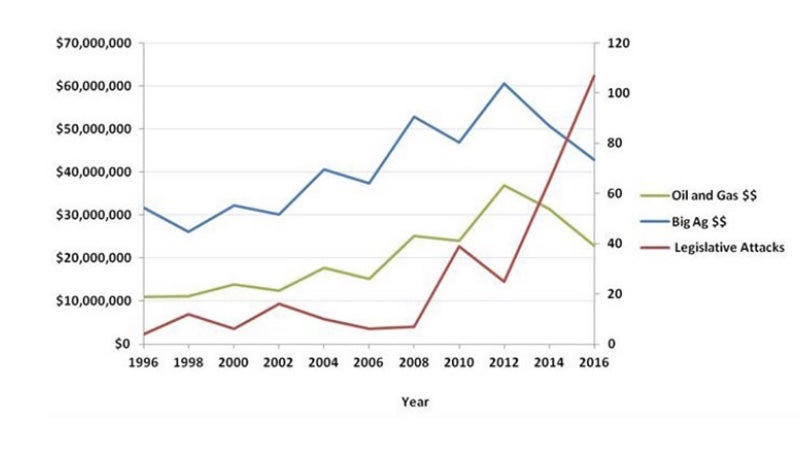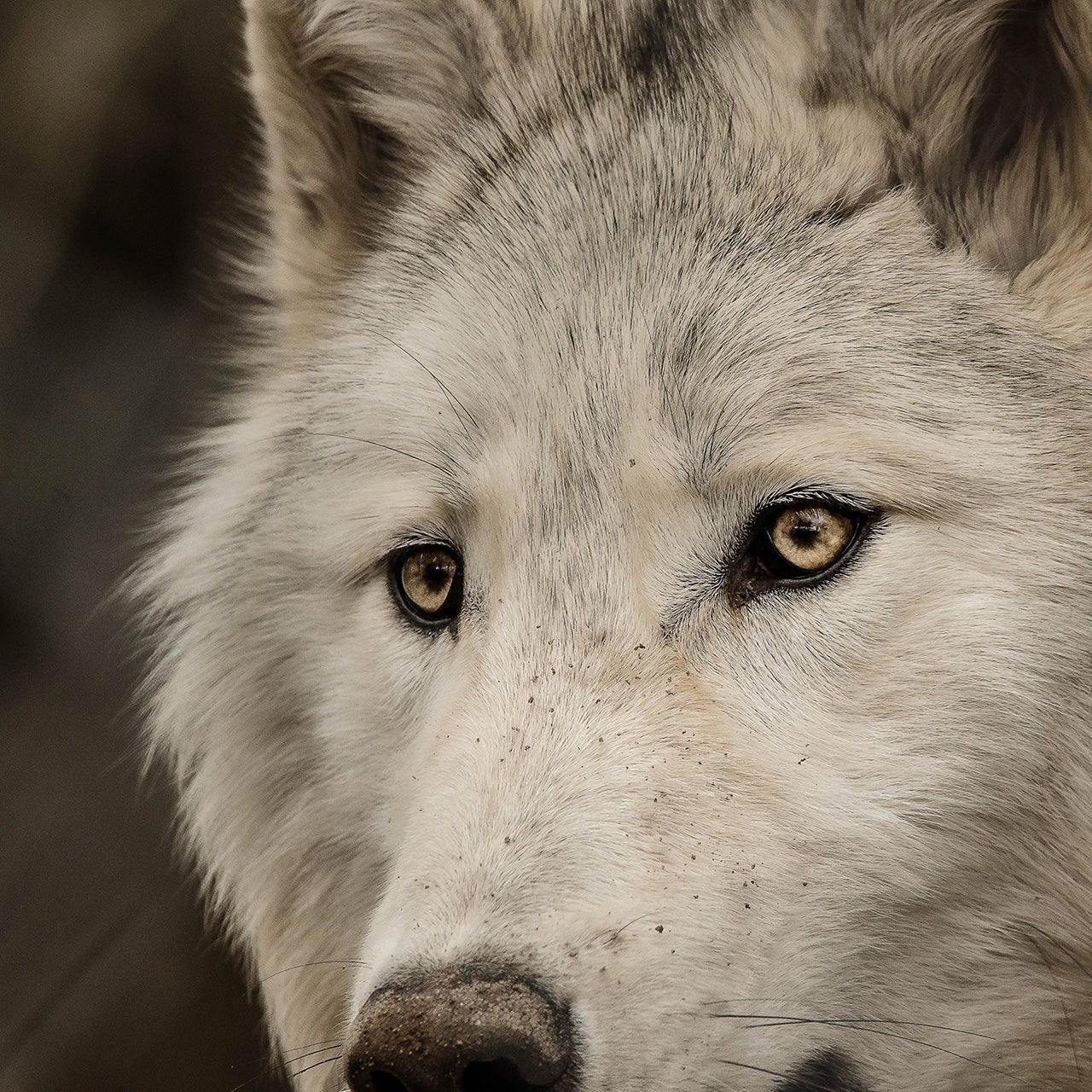Donald Trump’s tenure in the White House, along with the Republican Party’s reign in Congress, will be an unmitigated disaster for the environment. A is already underway for federal employees who support the science of climate change. Protections for the 640 million acres of public land you and I own in this country are already being . Oil and gas extraction on public land is expected to be , and even coal—a heavily polluting, inefficient energy source the market has rendered obsolete—. A victim of all of those programs, and even the target of specific GOP plans for eradication? The gray wolf, only recently reintroduced to western states to help check overpopulated elk and deer and restore balance to the natural food chain there.
Update: On January 17, 2017, Republican Senators introduced a bill nicknamed, “The War on Wolves Act.” If passed will not only remove ESA protections from wolves in Minnesota, Michigan, Wisconsin and Wyoming, but it will also strip citizens of the right to challenge it in court.
Where the Wolf Stands Today
It’s important to understand that the gray wolf, as a species, is not under threat overall—it’s just specific populations of wolves in certain geographic areas. There are approximately 60,000 wolves living in the wilds of Alaska and Canada. Those will only suffer the general impact of anti-environment policies, accelerated climate change, and habitat loss.
It’s the wolf populations reintroduced to the American West that GOP policy is directly targeting.
There’s also a population of more than 3,500 gray wolves in and around the Great Lakes—in Wisconsin, Michigan, and Minnesota—that, to a lesser extent, is also threatened.
Wolves were first brought back to the West in 1995, when 66 were brought from Canada to Yellowstone National Park and Idaho. also allowed for the natural southern dispersal of other wolf populations from Canada. Since then, the species has spread to Montana, Wyoming, Washington, and Oregon, and now there’s even a single pack living in Northern California. The population of wolves in those states —a huge success story for conservationists, albeit one that’s still ongoing. Wolves numbered 2 million on this continent just a couple hundred years ago but were killed off as modern civilization expanded westward.
As part of the reintroduction, the burgeoning population of gray wolves in the West was initially protected by the Endangered Species Act. Largely due to the controversial nature of the wolf reintroduction that we’ll get to a little later, however, those protections have variously been repealed, replaced, and repealed again at federal and local levels. Wolf populations have returned to just 10 percent of their original range in the West, making their existence there still tenuous and dependent on some sort of protection.
Why We Need Wolves
As an apex predator, wolves create a trophic cascade of benefits in their ecosystem, restoring balance the whole way down the food chain. (This process is explained very well in the video embedded above.)
In Yellowstone, for instance, the reintroduction of wolves corrected an imbalance caused by the unchecked expansion of ungulates. Historically, wolves kept the elk population in balance in that area; without them, the elk became too numerous and their movements too static. Grasslands were overgrazed. Willows, cottonwood, and aspen were damaged, destroying the riparian habitats of beavers, songbirds, otters, muskrats, ducks, fish, reptiles, and amphibians. Wolves fixed that. They also checked the population of coyotes, which preyed heavily on small animals. So those populations returned, too, along with the birds of prey that feed on them. The revitalized shrubbery produced more berries, expanding the bear population. The entire ecosystem benefited and was returned to balance by the mere reintroduction of a handful of wolves. It’s that whole circle of life thing that Elton John once sang about in that Disney movie.
Can wolves restore balance to ecosystems elsewhere in their historic range? , published in the scientific journal Trends in Ecology and Evolution, suggests they can, and that they may also enable the successful coexistence of invasive species with their native counterparts. The study argues that allowing the return of apex predators like the wolf may be much cheaper than trying to manage these environments through human methods.
Need a dollar amount to define their value? Wolves bring in to the Yellowstone area. Local businesses benefit from the mere presence of wolves.
Why Republicans Are Afraid of the Big Bad Wolf
Wolves kill and eat stuff. As described above, that’s their job. Things they like to kill and eat include things people like to kill and eat—primarily deer and elk, but also sometimes sheep and cattle. Which makes us rivals. Between 1995 and 2005, wolves killed 213 cattle and 173 sheep in Wyoming. The elk population has also fallen since the reintroduction of wolves, though drought, disease, and hunting also play a role. There were 17,000 elk in the park when the reintroduction began.
Perhaps due to an exaggerated presence of wolves in nursery rhymes and fairy tales, we humans also find them scary. There have been only due to wild wolves (two of which were rabid) in North America in the past 100 years. The number of people killed by wolves pales in comparison to the number of people who die each year due to, say, bee stings (in the United States, that’s ). Others complain that the loss of livestock hurts ranchers’ livelihood, even though state governments compensate ranchers for any losses. Still others lament the decrease in lucrative guided elk hunts in wolf states, though that has largely been attributed to an increase in out-of-state tag prices.
Politicians from rural areas have been pressured to address those unsubstantiated fears of their constituents, but that doesn’t come close to explaining the scale of the GOP’s war on wolves. The 114th Congress (2015–17) introduced 20 bills targeted at eliminating protections for the gray wolf alone. The Center for Biological Diversity (CBD) called it “the most anti-wildlife Congress we’ve ever had.” Until the 115th, that is.
Why exhaust so much time and energy attacking a single species? The real answer is that the protections wolves require in the West can run counter to the interests of industrial agriculture businesses and the oil and gas industry, both of which want to operate on land that is currently subject to protection because it’s wolf habitat.
The anti-wolf policies being paid for in part by industrial agriculture are actually damaging the small, family-owned farms where problems with wolves killing livestock actually take place and which are often cited as the cause for these policies. The killings disrupt pack order and disperse wolves into new areas, and weakened packs are forced to seek easier prey than the wild animals they’d otherwise focus on.
The CBD has and compared them with the number of bills introduced that threaten the Endangered Species Act (ESA). As campaign donations from the oil and gas industry and industrial agriculture have increased, so too have legislative assaults on the ESA. Because wolves have large ranges, the ESA may prevent energy extraction or industrial farming across larger areas than some other species. That explains the focus on removing the wolf’s protections.

How Republicans Will Kill the Wolf
In 1973, partly motivated by the plight of the bald eagle, President Richard Nixon called on Congress to take action to protect species on the verge of extinction. Congress created the by a nearly unanimous vote. Bald eagle populations have since increased from a low of 417 mating pairs to more than 11,000 today. That species was delisted (removed from the ESA’s protections) in 2007, although it remains subject to other protections as our national bird. Today, the ESA protects more than 1,600 endangered plants and animals.
As a depressing side note, .
Not every animal protected by the ESA is a success story. Due to the precarious nature of many of the species it protects, delistings are infrequent. Take, for instance, the case of the Death Valley pupfish. Only a handful exist in two ponds in Death Valley National Park. Totally isolated, it’s obviously unrealistic to expect that the species will ever expand its population enough that it will ever be considered anything but endangered. Does the pupfish deserve our protection? Environmentalists would say yes. And the law has prevented extinction for 99 percent of the species it protects. But Republicans argue no, because only 1 percent have been rehabilitated.
“It has never been used for the rehabilitation of species. It’s been used for control of the land,” argues House National Resources Committee Chairman Rob Bishop (R-Utah). He has stated that he “would love to invalidate” the ESA.
A representative survey of registered voters across the United States conducted in 2015 found that .
that congressional Republicans are preparing to amend the ESA, transforming it “from a tool to protect huge areas of habitat for imperiled species into little more than limits on hunting for protected animals.”
The wolf’s protection under the ESA has always been precarious. Due to the politically charged nature of their reintroduction, initial population targets that would trigger a delisting were set incredibly low—just 150 in Idaho, for instance. That didn’t sound like a viable population to wolf advocates, so, since the species started triggering delistings shortly after its reintroduction, its status has bounced back and forth both nationally and locally in that I’ll spare you a recap of it here.
Want to know what happens to wolves without ESA protection? Since 2009, when protections there began to erode, Idaho has killed 1,470 of its wolves, and .
To the best of my understanding, everywhere in the lower 48 with the exception of Montana, Idaho, and the eastern third of both Washington and Oregon. In large part, those protections are thanks to lawsuits conducted by environmental organizations like the CBD. Acknowledging that, Republican lawmakers have begun introducing anti-wolf laws as riders on essential budget bills, disturbingly including language that prevents legal challenge.
Trump has yet to go on the record about either the ESA or wolves, but he does oppose environmental policies that get in the way of drilling. It’s not expected that he’d veto any legislation designed to weaken or repeal the ESA or any riders intended to remove wolf protection. Trump’s nominee for interior secretary, Ryan Zinke, who will manage the U.S. Fish and Wildlife Service, which administers ESA programs, once sent out a Christmas card featuring a dead wolf. Last year, Zinke co-sponsored a bill designed to remove federal protections for wolves. It looks like the anti-wolf, anti-ESA Republican Congress is finally getting both the president it needs to rubber stamp this legislation, combined with an administrator of the Department of the Interior prepared to carry it out.
In addition to both that rollback of the ESA and likely direct challenges to the wolf’s inclusion in it, wolves are under threat from the GOP’s plan to steal our public lands. Like all wild animals, wolves need habitat to survive. Development of resource extraction on those lands will further threaten them.

What You Can Do About It
Well, you could start by not voting for politicians who drum up support based on manufactured and exaggerated populist issues, and then work to steal from you once they’re in office. Like , the war on wolves is another great example of that. If killing wolves results in increased wolf conflict for farmers, if wolves pose virtually no risk to human life, and if they’re essential to ecosystem rehabilitation in the West while bringing in tens of millions in tourist dollars, then remind me why we’re going to spend a bunch of taxpayer money killing them? Especially when . And you can stop voting for these jerks and enabling this behavior just because you think they’ll lower your taxes.
In the meantime, you can . Tell them you support the ESA, you don’t want them to steal our land, and that you oppose any legislation intended to remove wolf protection. While you’re at it, maybe ask them to start working in your interest, too.
You can also donate to organizations like the and . They’re the ones who will be fighting this legislation as much as possible through this historic assault on our environment, our wildlife, and our natural heritage.


